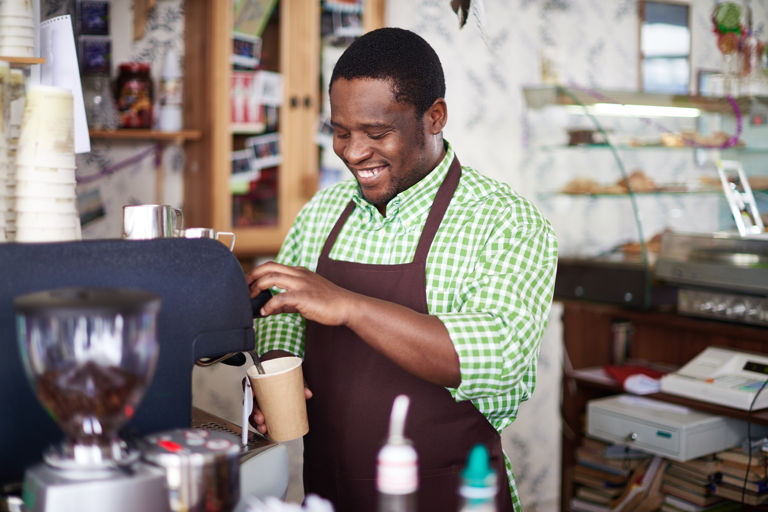How to open a café: A 10-step guide

Posted: Tue 17th Dec 2024
Last updated: Thu 23rd Jan 2025
14 min read
The café industry is vibrant and competitive, with countless establishments popping up in communities everywhere.
From artisanal coffee brews to delicious pastries, the café experience has become a beloved ritual for many.
But behind the enticing doors of a successful café lies meticulous planning, strategic choices and a well-defined roadmap to navigate the complexities of entrepreneurship.
If you're ready to take that leap into café ownership, having a clear, step-by-step guide can make all the difference.
This blog takes you through 10 essential steps designed to help you avoid common pitfalls and set the foundation for your dream business.
Whether you're a seasoned barista or a coffee connoisseur, these steps will equip you with the knowledge and confidence to brew up success in your very own café.
Contents
Step 1: Do your market research
Understanding the local market and your target customers' preferences isn't easy. Without thorough market research, you might struggle to attract customers or set yourself apart from your competitors.
Avoiding this predicament means identifying your target market – whether they're students, professionals or local residents – and analysing their preferences.
If you've never run a café before, spend time in a similar environment to get some experience and further your knowledge. Understanding your community and what type of venue is likely to work is crucial.
For example, a trendy or novelty café may not be suitable in a location where older clientele make up a core part of the local customer base.
Visit potential locations, study the competition and engage with the community through surveys or social media.
Researching food industry trends – such as the demand for specialty coffee, plant-based foods or eco-friendly practices – will inform your unique selling proposition (USP) and help you tailor your offerings.
Attending trade shows is a great way to pick up ideas, meet suppliers and gain insight into aspects like pricing.
You should get every detail about what makes your café special sorted before opening.
VIDEO: Why doing market research helps you set business goals
Learn how market research can supercharge your business, how to identify the different types you can use and how to ask customers great questions:
Step 2: Develop a solid business plan
Many aspiring café owners underestimate the importance of a well-structured business plan.
If you don't have clear objectives and financial projections guiding you, securing funding and managing things day to day becomes far more challenging.
So what should you do? Work on outlining a detailed concept for your business, including your café's theme, menu and pricing strategy.
A financial plan should estimate the costs of starting up, ongoing costs and the revenue you expect to generate. On top of that, a strong marketing and operational strategy will keep your business on track.
A solid café business plan not only guides your decisions but also makes you more credible in the eyes of potential investors or finance providers.
Use Enterprise Nation's business plan template to start things off.
Step 3: Secure financing
Determining the initial costs of starting up – and then getting that funding in place – can be one of the biggest challenges when setting up a café business.
How much does it cost to open a café? Well, in the UK, it can range from £20,000 to £100,000, depending on where you set up shop and the business model you've settled on.
To secure finance, explore all the options available to you, whether it's personal savings, bank loans, crowdfunding, money from angel investors or government grants.
By carefully planning your financial strategy, you can make sure your café remains viable even in its early stages.
If you need funding to cover your start-up costs, consider the government-backed Start Up Loans, which provides business loans up to £25,000.
Looking for finance for your business?
Personalised finance options for start-ups, small businesses, sole traders and freelancers.
Take the Funding Hub tool and get recommendations tailored to your financial needs.
Step 4: Choose the perfect location
Where you base your café is one of the most important factors in deciding its success.
Consequently, you must thoroughly research possible café locations and what it costs to rent or buy premises in those area.
Busy areas with lots of passing foot traffic may be an ideal spot for a café, although prime locations often come with higher rent.
Looking at where the biggest coffee chains like Costa, Starbucks and Caffe Nero have set up can demonstrate where in the city or town is particularly desirable for that type of business.
To find a balance, consider areas near offices, universities or shopping districts, where potential customers are likely to visit regularly. Before you sign any contracts for premises, do a foot traffic analysis to assess customer flow.
For a small café covering 10 to 50 customers, you'd need between 500 and 1,000 square feet of space. It should include room for a kitchen, storage and a retail section.
Before you commit to a space, always check if the layout would meet the arrangements you have in mind, and whether the building can be commercially rented and insured.
Step 5: Know your legal requirements and keep to them
To operate a café in line with the law, you must register your business either with:
HMRC (if you're a sole trader)
Companies House (if you're a limited company)
As it's a food business, you must also register with your local authority at least one month before opening.
Any business that serves food needs to comply with the regulations from the Food Standards Agency (FSA) – the government-appointed body responsible for all food safety standards.
There's lots of information on the FSA website about food safety management procedures and food hygiene matters you need to be aware of as a catering business. At least one staff member should have Level 2 Food Hygiene and Safety certification (available online).
The Health and Safety Executive (HSE) website is a good source of information on health and safety rules for your café. It's your responsibility to keep your premises safe for employees and customers, so there's as little risk to people coming in and out as possible.
Acquiring the necessary licences – such as a premises licence if you're serving alcohol or late-night refreshments, and a pavement licence if you plan to have outside seating – is crucial.
VIDEO: How to avoid costly legal mistakes as a small business
Lawyer Patricia Wing uncovers the top legal pitfalls start-up founders face and shares proven strategies to avoid them, allowing you to focus on your business:
Step 6: Design an inviting atmosphere
A café's ambiance plays a significant role in attracting and retaining customers. Creating a comfortable and unique environment can set you apart from competitors.
Invest in interior design that fits with your brand, making sure elements like seating, lighting and music contribute to a welcoming atmosphere.
Accessibility should also be a priority, so all customers, including those with disabilities, feel comfortable.
A well-designed space keeps visitors around for longer and encourages them to return. It's also a good way to get those positive word-of-mouth referrals and create an incredible sense of community.
Step 7: Find high-quality suppliers
Having a consistently high standard of product relies heavily on finding suppliers you can depend on.
A poorly sourced supply chain can lower the quality of the food and drinks you supply, which will ultimately damage customer trust.
You can prevent this by partnering with reputable local coffee roasters and food suppliers. Prioritising sustainability by sourcing ethically produced coffee beans and organic ingredients can also appeal to environmentally conscious customers.
Building strong relationships with suppliers will help make sure deliveries are made in good time and the standard of product you provide remains consistently excellent.
Step 8: Hire and train competent staff
Your business is only as good as your staff.
There are no necessary qualifications your employees must get before working for you, but recruiting the most experienced and efficient staff you can find will help your business succeed.
Staffing issues can have a significant impact on the quality of your service and the overall customer experience.
Hiring employees who fit your brand values and have excellent customer service skills is essential.
Once you've hired the right people, give them formal training in areas such as preparing coffee, food safety and customer interaction.
Fostering a positive working environment can keep morale high and ensure staff remain on board with the business.
Well-trained and motivated employees enhance your café's overall atmosphere and keep loyal customers happy to come back.
VIDEO: Hiring the right people for your small business
Business adviser Tony Mulvahil shares techniques to help you find the best people for your business and build a positive culture that fosters success:
Step 9: Implement an effective marketing strategy
Attracting and retaining customers in what is a very competitive market requires an effective marketing plan.
Social media marketing and email marketing are powerful tools for showcasing your café, engaging with potential customers and promoting special offers.
Introducing a loyalty programme can encourage repeat visits, while organising community events or collaborations with local businesses can boost exposure.
In the beginning, you should promote your business online and offline. Claim your Google Business Profile – this lists the business on Google and makes it visible to people in your area who aren't yet regular customers.
Promote your café offline as well, which you can do by handing out flyers on the opening day, organising recurring food deals and running coffee loyalty offers.
Delivering top-quality service should help inspire loyalty and encourage customers to return.
Step 10: Prepare for financial management
If your café is going to remain profitable over the long term, you must manage the business's finances effectively.
Poor financial management can cause unexpected issues with cash flow, making the business difficult to sustain.
To stay on top of finances, use accounting software to track expenses and revenue. Regularly reviewing your financial statements will help you identify cost-saving opportunities and keep the business on a stable financial footing.
Being diligent with monitoring your cash flow will ensure your café remains financially viable, even during those periods when business is slow.
Final thoughts
Starting a café in the UK requires careful planning, financial foresight and an understanding of market dynamics.
By addressing all the potential challenges and putting in place good solutions as part of a strong business strategy, you can create a thriving café that serves your community well.
Relevant resources
Looking to break into the food industry?
Imagine owning a successful food business, attracting loyal customers and watching your passion turn into a thriving enterprise.



